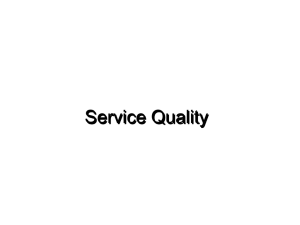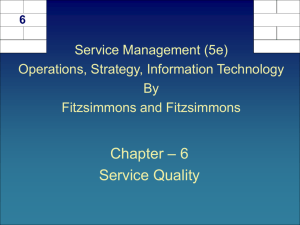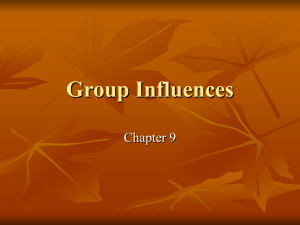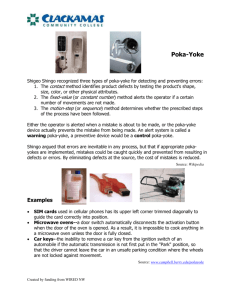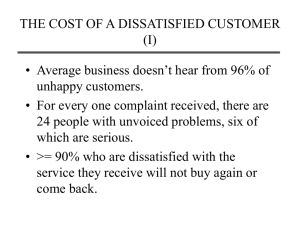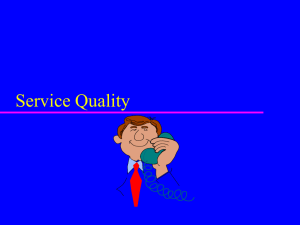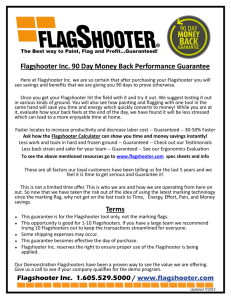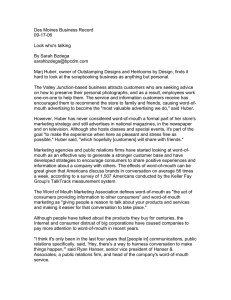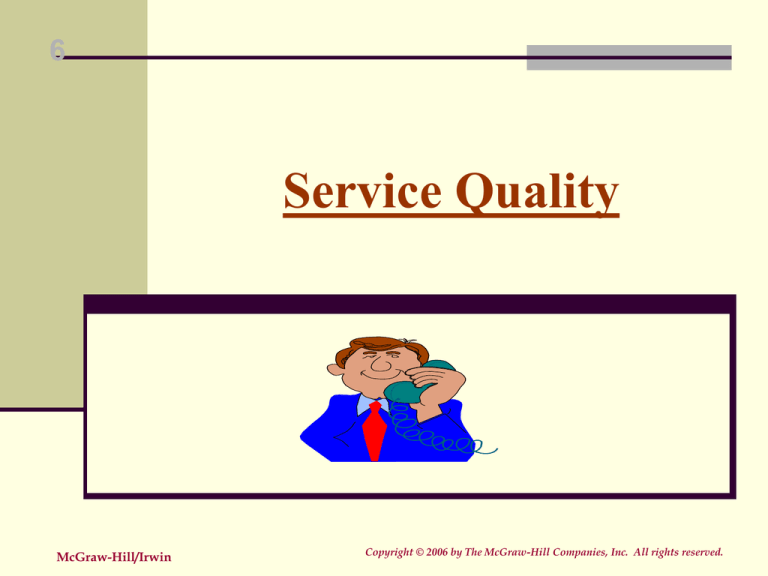
6
Service Quality
McGraw-Hill/Irwin
Copyright © 2006 by The McGraw-Hill Companies, Inc. All rights reserved.
Service Guarantee
(100% Satisfaction Guarantee)
Offer dissatisfied customer a refund,
discount, or free service.
Advertising the firm’s commitment to quality
Focuses employees by defining performance
standards explicitly
Builds a loyal customer base
Motivating effect on employees
Customer feedback
Service Quality is measured by comparing
a customer’s expected service, which comes
from word-of-mouth, personal needs and
past experience, with his or her perceptions
of service.
The Measurement
of Satisfaction is
based on whether the expectations were
met, not met, or exceeded.
Moments of Truth
Each customer contact is called a
moment of truth.
You have the ability to either satisfy or
dissatisfy them when you contact them.
A service recovery is satisfying a
previously dissatisfied customer and
making them a loyal customer.
Dimensions of Service Quality
Reliability: Perform promised service
dependably and accurately. Example:
receive mail at same time each day.
Responsiveness: Willingness to help
customers promptly. Example: avoid
keeping customers waiting for no apparent
reason.
Dimensions of Service Quality
Assurance: Ability to convey trust and
confidence. Example: being polite and
showing respect for customer.
Empathy: Ability to be approachable.
Example: being a good listener.
Tangibles: Physical facilities and
facilitating goods. Example: cleanliness.
Perceived Service Quality
Word of
mouth
Service Quality
Dimensions
Reliability
Responsiveness
Assurance
Empathy
Tangibles
Personal
needs
Expected
service
Perceived
service
Past
experience
Service Quality Assessment
1. Expectations exceeded
ES<PS (Quality surprise)
2. Expectations met
ES~PS (Satisfactory quality)
3. Expectations not met
ES>PS (Unacceptable quality)
Service Quality Gap Model
Customer
Perceptions
Managing the
Evidence
Customer Satisfaction
GAP 5
Customer
Expectations
Customer /
Marketing Research
GAP 1
Communication
GAP 4
Understanding
the Customer
Management
Perceptions
of Customer
Expectations
Service
Delivery
Conformance
GAP 3
Design GAP 2
Conformance
Service
Standards
Service Design
Quality Service by Design
Quality in the Service Package
Budget Hotel example
Taguchi Methods (Robustness)
Notifying maids of rooms for cleaning
Poka-yoke (fail-safing)
Height bar at amusement park
Quality Function Deployment
House of Quality
Poka-yoke
Shigeo Shingo believed that Low-cost, In-process
quality-control mechanisms and routines used by
employees in their work could achieve high quality
w/o costly inspection.
Use checklists or manual devices that do not let
the employee make a mistake. “Foolproof” devices
Enhances cleanliness and the aesthetic quality of
the service.
Reminds workers of steps often forgotten in
hurrying to satisfy customers in a timely manner.
Classification of Service Failures
with Poka-Yoke Opportunities
Server Errors
Customer Errors
Task:
Doing work incorrectly
Treatment:
Failure to listen to
customer
Tangible:
Failure to wear clean
uniform
Preparation:
Failure to bring necessary
materials
Encounter:
Failure to follow system
flow
Resolution:
Failure to signal service
failure
House of Quality (Q Function Development)
Customer Input at Product Design Stage
Relationships
*
Strong
Medium
O
Reliability
9
8
Responsiveness
7
3
Assurance
6
5
Empathy
4
Tangibles
2
Capacity
Attitude
Training
Customer Expectations
9
9
Equipment
*
*
Servic e Elements
Im
po
rta
nc
e
5
5
3
2
2
1 2 3 4 5
+ o
o
+
+
3
o
o
o
o
_
Improvement difficulty rank
+ Volvo Dealer
7
o
Weighted score
Customer Perc eptions
o Village Volvo
6
+
Comparison with Volvo Dealer
127 82
4
5
Weak
O
Informatiion
Relati ve
O
63 102
1
3
65
2
+
+
o
o
o
Achieving Service Quality
Cost of Quality (Juran)
Service Process Control
Statistical Process Control (Deming)
Unconditional Service Guarantee
Costs of Service Quality
(Bank Example)
Failure costs
External failure:
Loss of future business
Negative word-of-mouth
Liability insurance
Legal judgments
Interest penalties
Internal failure:
Scrapped forms
Rework
Recovery:
Expedite disruption
Labor and materials
Detection costs
Prevention costs
Process control
Peer review
Supervision
Customer comment card
Inspection
Quality planning
Training program
Quality audits
Data acquisition and analysis
Recruitment and selection
Supplier evaluation
Percentage of ontime
flights
Control Chart of Departure
Delays
100
expected
90
Lower Control Limit
80
70
60
1998
UCL p Z
p (1 p
n
1999
LCL p Z
p (1 p
n
6-15
Service Process Control
Customer
input
Service
process
Resources
Take
corrective
action
Identify reason
for
nonconformance
Service
concept
Customer
output
Monitor
conformance to
requirements
Establish
measure of
performance
Unconditional Service Guarantee:
Customer View
Unconditional (L.L. Bean)
Easy to understand and communicate
(Bennigan’s)
Meaningful (Domino’s Pizza)
Easy to invoke (Cititravel)
Easy to collect (Manpower)
Unconditional Service Guarantee:
Management View
Focuses on customers (British Airways:
Care, Concern, Initiative, Problem Solving, Recovery)
Sets clear standards (FedEx)
Guarantees feedback (Manpower)
Promotes an understanding of the service
delivery system (Bug Killer)
Builds customer loyalty by making
expectations explicit
Disney’s SERVICE
Smile
Eye contact & Body language
Respect & Welcome
Value the Magic
Initiate Guest Contact
Create Service Solutions
End W/ a "Thank You"
Customer Satisfaction
All customers want to be satisfied.
Customer loyalty is only due to the lack of a
better alternative.
Giving customers some extra value will
delight them by exceeding their expectations
and insure their return.
Categories of Tipping Behavior
Person-to-Person Service
Time the server spends at table doing extra...
# visits to table by server after entree’s been served
Average # of times server refills drink glasses
Service Delays -- customers don’t want to be
ignored once they have arrived
Ambience Variables-
Lighting Level
Music Level
Color Scheme
Presence of Cooking Smells
Check Presentation
Promotion and Suggestive Selling
Customer Feedback and
Word-of-Mouth
The average business only hears from 4% of
their customers who are dissatisfied with
their products or services. Of the 96% who
do not bother to complain, 25% of them
have serious problems.
The 4% complainers are more likely to stay
with the supplier than are the 96% noncomplainers.
Customer Feedback and
Word-of-Mouth (Cont)
About 60% of the complainers would stay as
customers if their problem was resolved and
95% would stay if the problem was resolved
quickly.
A dissatisfied customer will tell between 10
and 20 other people about their problem.
A customer who has had a problem resolved
by a company will tell about 5 people about
their situation.
Walk-Through-Audit
Service delivery system should conform to
customer expectations.
Customer impression of service influenced
by use of all senses.
Service managers lose sensitivity due to
familiarity.
Need detailed service audit from a
customer’s perspective.
Approaches to Service Recovery
Case-by-case addresses each customer’s complaint
individually but could lead to perception of
unfairness.
Systematic response uses a protocol to handle
complaints but needs prior identification of critical
failure points and continuous updating.
Early intervention attempts to fix problem before
the customer is affected.
Substitute service allows rival firm to provide
service but could lead to loss of customer.

